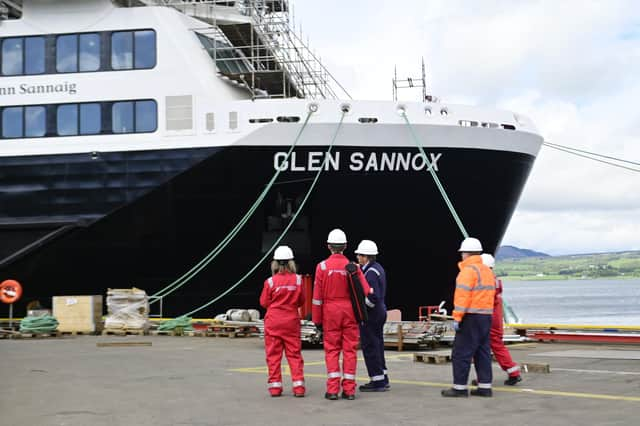Ferries built at Ferguson Marine 'more complex than Type 26 frigate' says yard CEO


Two delayed and overbudget ferries being built at Ferguson Marine shipyard are “more complex than Type 26 frigates”, the chief executive of the yard has claimed.
David Tydeman, giving evidence to Holyrood’s net zero, energy and transport committee, also said the final value of the ships will be around £70m each, well below the £360m spent to construct them.
Advertisement
Hide AdAdvertisement
Hide AdThe shipyard boss said the Glen Sannox will cost £200m, while the Glen Rosa will cost £160m, and detailed the litany of mistakes in construction giving the example of hydraulic pipework being installed with mild steel as opposed to stainless steel.
The yard chief said the design work on the Glen Sannox and Glen Rosa was more complex than any other ship in the CalMac fleet, but that the design was finally complete.
He said: “The vessel is made complex by the need to fit a lot of systems and major components into restricted spaces.
"In this sense, these two ferries are far more complex than the Loch Seaforth, the largest vessel in the current fleet, and more complex than the four ferries being built in Turkey for CMAL.
"The design challenges have been very substantial, more complex than the Type 26 [frigate] according to senior industry visitors I’ve had on site.”
Mr Tydeman was also challenged on his claim that a “different approach” to fire safety rules directly led to an increase of £24m in the cost to build two ferries.
Construction of the two ferries was delayed again with a further increase in costs in September due to this design change, meaning the second ship, Glen Rosa, will now not sail until May 2025.
Previously, Mr Tydeman claimed these safety issues were “largely but not exclusively, due to the Maritime and Coastguard Agency (MCA) taking a different approach to regulation of crew escape from 801”.
Advertisement
Hide AdAdvertisement
Hide AdHe added this was “not a minor thing” but was “pretty fundamental to whether the design of the ferry allows it to sail.”
However, he admitted to MSPs that overconfidence within the yard was the central reason for the failure to anticipate the safety concerns being raised by the MCA.
Mr Tydeman also blamed a “disconnect” between advice the local branch of the MCA provided to Ferguson’s and what the head office in Southampton had advised.
This came after the MCA denied changing the way it applied the rules during the construction of the ships.
In a letter to Holyrood’s net zero, energy and transport committee, the chief executive of the MCA, Virginia McVea, said the agency had been “consistent” in its application of safety rules.
She said: “For Ferguson Hull 801 and 802 there has been no reassessment of the application of Chapter 13 of the Fire Systems Safety Code as the requirements have not changed.”
Ms McVea added that the so-called “cargo ship” rules referenced by Mr Tydeman had been in place since 2009 and is legally required to be met under 2020 legislation.
Minor amendments of the rules have been brought forward, but “none of the...amendments would have made any difference to the rules applicable to these ships”.
Advertisement
Hide AdAdvertisement
Hide AdAsked to justify blaming the MCA for the additional work required, Mr Tydeman said the yard had undertaken modelling following conversations with the local MCA branch to ensure it met safety standards.
However, this did not satisfy the MCA when final designs were submitted.
Pressed by committee convenor, Edward Mountain, on why the yard ended up in this situation, the chief executive said: “We were perhaps overconfident that we were going to get all of these exemptions based on the modelling and the conversations last year.
"And it was a bit of a surprise when we had to do the design changes that we’ve done over the last few months.”
Mr Tydeman said the ship’s design while in private ownership assumed it could use cargo areas for passenger evacuation, and that the yard had had advice stating this would be acceptable.
He added: “The ship was designed with those assumptions in mind and those conversations on how we would get approval for the ship have been going on with the local office, finally overruled by the head office...in April this year.”
A source close to the committee said several people should now lose their jobs.
They said: “I cannot believe that after all of this incompetence that more than one person won’t lose their job within the management of the yard, CMAL, Transport Scotland, or the Scottish Government.”
Advertisement
Hide AdAdvertisement
Hide AdScottish Conservative transport spokesperson Graham Simpson said the evidence demonstrated the “sheer scale of incompetence” impacting the yard.
He said: “[Mr Tydeman] highlighted the astonishing failures in design and the botched wiring and cabling work that lies at the heart of this fiasco.
“The buck for this scandal stops with SNP ministers who have presided over this mess – first by inexplicably awarding the contract to Ferguson, then by failing to get a grip of spiralling costs and delays post-nationalisation. Yet still they refuse to accept responsibility for their catastrophic failings.”
Comments
Want to join the conversation? Please or to comment on this article.
